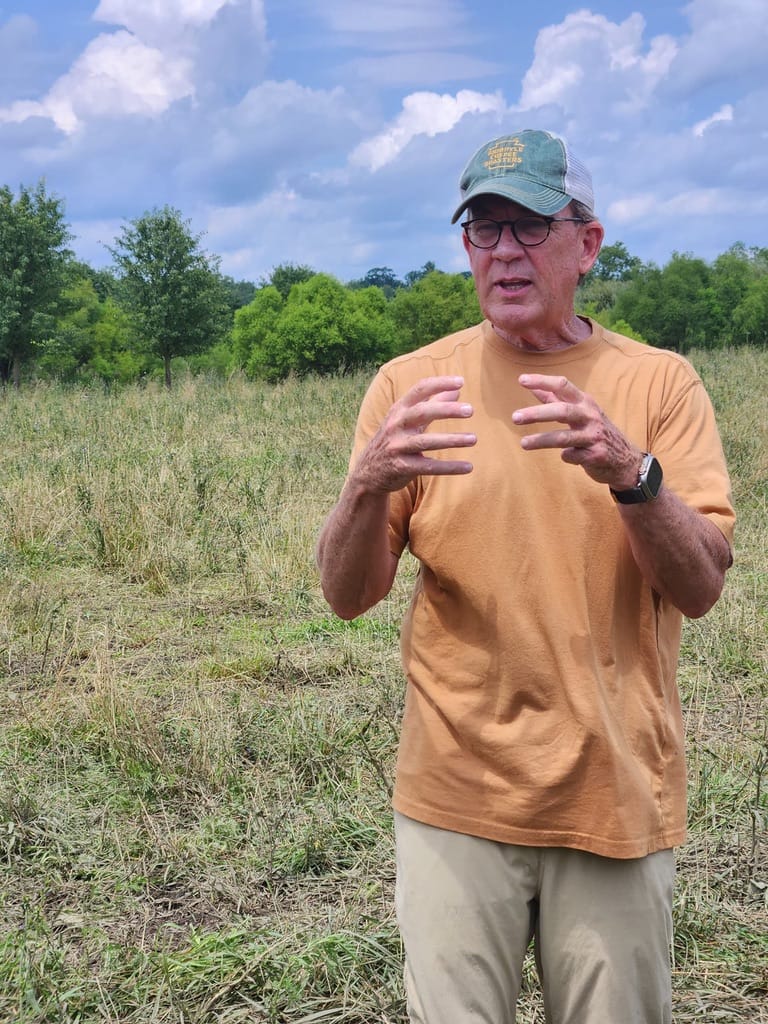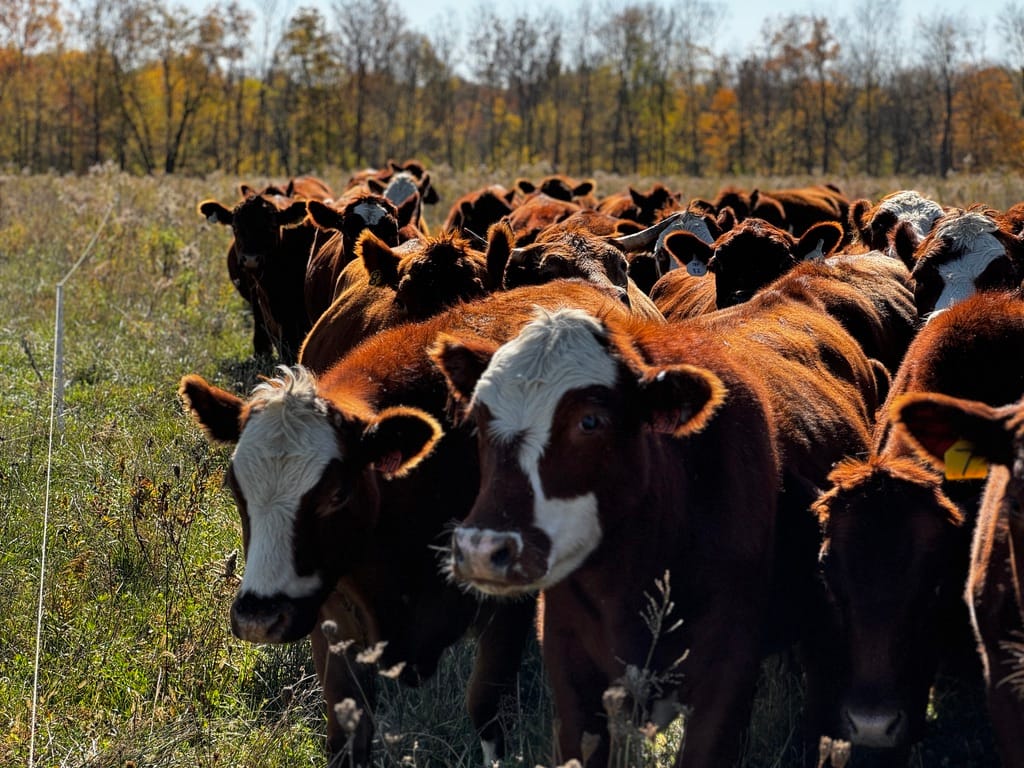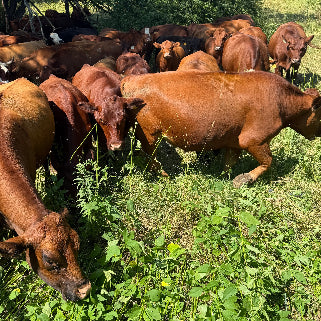
The Power of Grasslands: The Benefits of Restoring Grassland Ecosystems for Environmental Regeneration
To understand the importance of Holistically Managed Grasslands, it's important to review how Sun Energy, Plants, Herbivores and Water work together to literally create the world as we know it.
 Whatever anybody's individual thoughts are around Climate Change, we can all agree that less carbon in the atmosphere and less runoff and erosion is a good thing.
Increasing the area covered by grasslands is a promising solution for sequestering carbon from the atmosphere. Grassland ecosystems are more efficient than other land cover systems in terms of their ability to trap and store atmospheric carbon. Regenerating grasslands provides numerous economic and environmental benefits, such as improved water quality, an increase in biodiversity, and enhanced agricultural productivity. Furthermore, it has been widely accepted that grasslands are one of the most effective ways to reduce atmospheric Carbon Dioxide on a local scale. Therefore, investing in grassland management (which requires Grassfed Beef) could help achieve the following goals:
Whatever anybody's individual thoughts are around Climate Change, we can all agree that less carbon in the atmosphere and less runoff and erosion is a good thing.
Increasing the area covered by grasslands is a promising solution for sequestering carbon from the atmosphere. Grassland ecosystems are more efficient than other land cover systems in terms of their ability to trap and store atmospheric carbon. Regenerating grasslands provides numerous economic and environmental benefits, such as improved water quality, an increase in biodiversity, and enhanced agricultural productivity. Furthermore, it has been widely accepted that grasslands are one of the most effective ways to reduce atmospheric Carbon Dioxide on a local scale. Therefore, investing in grassland management (which requires Grassfed Beef) could help achieve the following goals:
 Photosynthesis is the process by which plants convert light energy, water, and carbon dioxide into glucose (sugar) and oxygen. During photosynthesis, energy from the sun is absorbed by specialized plant pigments such as chlorophyll in leaves and converted into chemical energy. This energy is then used to synthesize glucose molecules from carbon dioxide and water molecules. As a result of this process, oxygen is released into the atmosphere while the newly formed glucose molecule provides a source of fuel for plant growth.
Additionally, during photosynthesis, carbon dioxide (CO2) from the atmosphere is "sequestered" or taken up by plants for use in creating glucose molecules. This effectively removes CO2 from the atmosphere, making it an important part of the global carbon cycle. Plants that are actively photosynthesizing can therefore play a key role in mitigating some of the consequences of atmospheric carbon by sequestering CO2 and converting it into plant material.
Overall, photosynthesis is a vital process that underpins life on Earth, allowing plants to produce food from light energy while simultaneously helping regulate the global carbon cycle. It demonstrates how organisms can interact with their environment in complex ways to create mutually beneficial outcomes for all involved. Farming Holistically takes all this into consideration.
Photosynthesis is the process by which plants convert light energy, water, and carbon dioxide into glucose (sugar) and oxygen. During photosynthesis, energy from the sun is absorbed by specialized plant pigments such as chlorophyll in leaves and converted into chemical energy. This energy is then used to synthesize glucose molecules from carbon dioxide and water molecules. As a result of this process, oxygen is released into the atmosphere while the newly formed glucose molecule provides a source of fuel for plant growth.
Additionally, during photosynthesis, carbon dioxide (CO2) from the atmosphere is "sequestered" or taken up by plants for use in creating glucose molecules. This effectively removes CO2 from the atmosphere, making it an important part of the global carbon cycle. Plants that are actively photosynthesizing can therefore play a key role in mitigating some of the consequences of atmospheric carbon by sequestering CO2 and converting it into plant material.
Overall, photosynthesis is a vital process that underpins life on Earth, allowing plants to produce food from light energy while simultaneously helping regulate the global carbon cycle. It demonstrates how organisms can interact with their environment in complex ways to create mutually beneficial outcomes for all involved. Farming Holistically takes all this into consideration.
 ing life on Earth by providing plants with the energy they need for growth and development.
Grasslands play an important role in cooling the ground, due to transpiration. When water from soil enters plant tissues and is then released into the atmosphere as vapor it reduces ambient air temperature. The presence of healthy grassland ecosystems increases this cooling effect, making it an effective way to combat overheating in grass fed cattle as well as the overall biodiversity. In our pastures we see ground temperatures 20 degrees lower than air temperatures in the heat of summer.
ing life on Earth by providing plants with the energy they need for growth and development.
Grasslands play an important role in cooling the ground, due to transpiration. When water from soil enters plant tissues and is then released into the atmosphere as vapor it reduces ambient air temperature. The presence of healthy grassland ecosystems increases this cooling effect, making it an effective way to combat overheating in grass fed cattle as well as the overall biodiversity. In our pastures we see ground temperatures 20 degrees lower than air temperatures in the heat of summer.
How Photosynthesis & Transpiration Support the Global Carbon Cycle
 Whatever anybody's individual thoughts are around Climate Change, we can all agree that less carbon in the atmosphere and less runoff and erosion is a good thing.
Increasing the area covered by grasslands is a promising solution for sequestering carbon from the atmosphere. Grassland ecosystems are more efficient than other land cover systems in terms of their ability to trap and store atmospheric carbon. Regenerating grasslands provides numerous economic and environmental benefits, such as improved water quality, an increase in biodiversity, and enhanced agricultural productivity. Furthermore, it has been widely accepted that grasslands are one of the most effective ways to reduce atmospheric Carbon Dioxide on a local scale. Therefore, investing in grassland management (which requires Grassfed Beef) could help achieve the following goals:
Whatever anybody's individual thoughts are around Climate Change, we can all agree that less carbon in the atmosphere and less runoff and erosion is a good thing.
Increasing the area covered by grasslands is a promising solution for sequestering carbon from the atmosphere. Grassland ecosystems are more efficient than other land cover systems in terms of their ability to trap and store atmospheric carbon. Regenerating grasslands provides numerous economic and environmental benefits, such as improved water quality, an increase in biodiversity, and enhanced agricultural productivity. Furthermore, it has been widely accepted that grasslands are one of the most effective ways to reduce atmospheric Carbon Dioxide on a local scale. Therefore, investing in grassland management (which requires Grassfed Beef) could help achieve the following goals:
- Reduced atmospheric carbon levels
- Improved water quality
- Increased biodiversity
- Enhanced agricultural productivity
- Increased soil fertility
- Soil stability/Mitigate Runoff and Erosion
- Improved air quality
Exploring How Photosynthesis & Transpiration Aid in Climate Change Mitigation Strategies
We all (kind-of) learned about Photosynthesis in 3rd grade. But as a refresher maybe revisit the high points… (I asked ChatGPT to assist) Photosynthesis is the process by which plants convert light energy, water, and carbon dioxide into glucose (sugar) and oxygen. During photosynthesis, energy from the sun is absorbed by specialized plant pigments such as chlorophyll in leaves and converted into chemical energy. This energy is then used to synthesize glucose molecules from carbon dioxide and water molecules. As a result of this process, oxygen is released into the atmosphere while the newly formed glucose molecule provides a source of fuel for plant growth.
Additionally, during photosynthesis, carbon dioxide (CO2) from the atmosphere is "sequestered" or taken up by plants for use in creating glucose molecules. This effectively removes CO2 from the atmosphere, making it an important part of the global carbon cycle. Plants that are actively photosynthesizing can therefore play a key role in mitigating some of the consequences of atmospheric carbon by sequestering CO2 and converting it into plant material.
Overall, photosynthesis is a vital process that underpins life on Earth, allowing plants to produce food from light energy while simultaneously helping regulate the global carbon cycle. It demonstrates how organisms can interact with their environment in complex ways to create mutually beneficial outcomes for all involved. Farming Holistically takes all this into consideration.
Photosynthesis is the process by which plants convert light energy, water, and carbon dioxide into glucose (sugar) and oxygen. During photosynthesis, energy from the sun is absorbed by specialized plant pigments such as chlorophyll in leaves and converted into chemical energy. This energy is then used to synthesize glucose molecules from carbon dioxide and water molecules. As a result of this process, oxygen is released into the atmosphere while the newly formed glucose molecule provides a source of fuel for plant growth.
Additionally, during photosynthesis, carbon dioxide (CO2) from the atmosphere is "sequestered" or taken up by plants for use in creating glucose molecules. This effectively removes CO2 from the atmosphere, making it an important part of the global carbon cycle. Plants that are actively photosynthesizing can therefore play a key role in mitigating some of the consequences of atmospheric carbon by sequestering CO2 and converting it into plant material.
Overall, photosynthesis is a vital process that underpins life on Earth, allowing plants to produce food from light energy while simultaneously helping regulate the global carbon cycle. It demonstrates how organisms can interact with their environment in complex ways to create mutually beneficial outcomes for all involved. Farming Holistically takes all this into consideration.
What is Transpiration and what does it have to do with the Environment?
Grasslands also play an important role in cooling the ground, due to the process of transpiration. Transpiration is a process whereby plants release water from their leaves in the form of vapor. This occurs when tiny pores on the surface of plant leaves, known as stomata, open to allow for gas exchange between the atmosphere and internal leaf tissues. During transpiration, the water evaporates from inside the leaf into an area of lower humidity (the air) and carries with it important minerals and nutrients necessary for plant growth. Transpiration also helps to cool down plants by releasing excess heat that may have built up during photosynthesis. By regulating its rate of transpiration, a plant can maintain a steady temperature even in a rapidly changing environment. Overall, transpiration is an essential process which allows plants to regulate their internal temperature while also ensuring the transport of essential minerals and nutrients. It is an integral part of a plant’s life cycle, helping to ensure their survival in a constantly changing environment. As such, transpiration plays an important role in support ing life on Earth by providing plants with the energy they need for growth and development.
Grasslands play an important role in cooling the ground, due to transpiration. When water from soil enters plant tissues and is then released into the atmosphere as vapor it reduces ambient air temperature. The presence of healthy grassland ecosystems increases this cooling effect, making it an effective way to combat overheating in grass fed cattle as well as the overall biodiversity. In our pastures we see ground temperatures 20 degrees lower than air temperatures in the heat of summer.
ing life on Earth by providing plants with the energy they need for growth and development.
Grasslands play an important role in cooling the ground, due to transpiration. When water from soil enters plant tissues and is then released into the atmosphere as vapor it reduces ambient air temperature. The presence of healthy grassland ecosystems increases this cooling effect, making it an effective way to combat overheating in grass fed cattle as well as the overall biodiversity. In our pastures we see ground temperatures 20 degrees lower than air temperatures in the heat of summer.
Tags:
Previous post
The Truth About Grass fed Beef (Part 2)
Next post
















